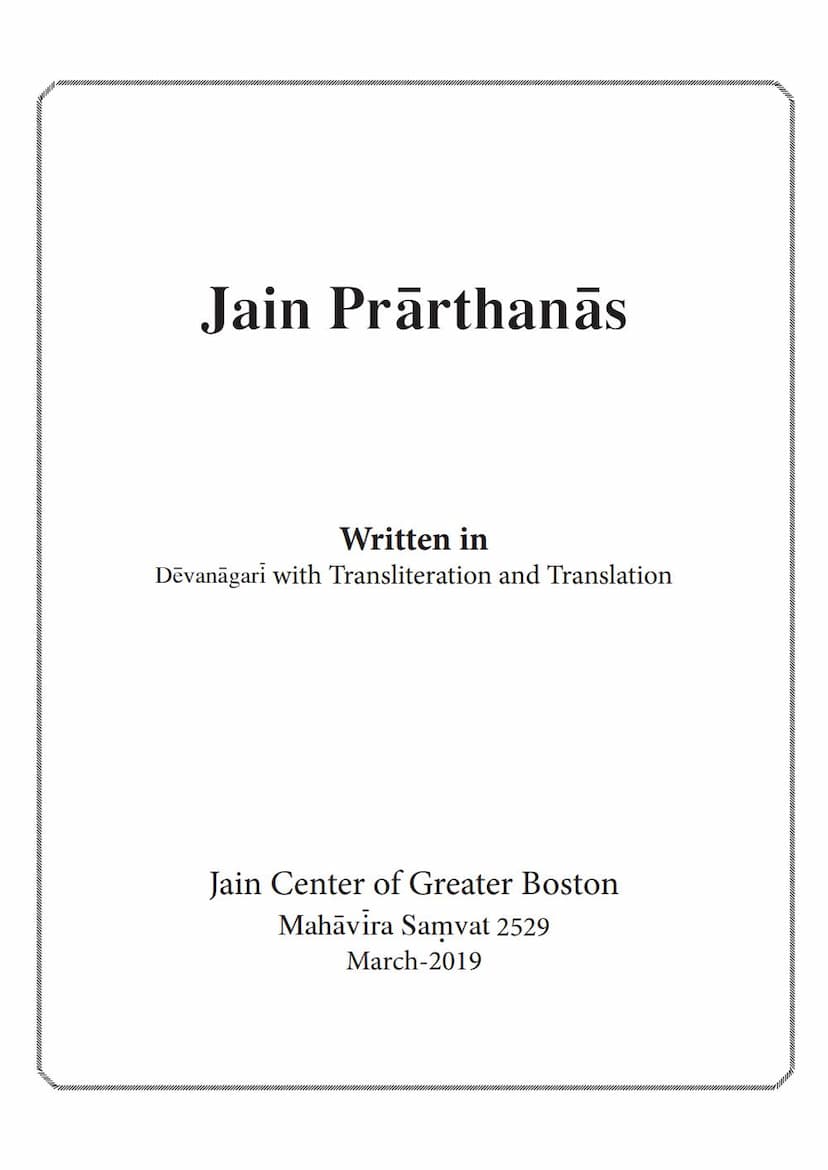Jain Prarthanas
Added to library: September 2, 2025

Summary
This document is a compilation of Jain prayers (Prarthanas) and sacred verses (Sutras) published by the Jain Center of Greater Boston (JCGB) in March 2019, corresponding to Mahavira Samvat 2529. The booklet is dedicated to Acharya Shrimad Vijaya Suryodaya Suriji and his disciple Pannyasa Shri Nandighosh Vijayji for their work in disseminating the scientific aspects of Jainism.
Key Features and Content:
- Purpose: The booklet aims to provide popular Jain prayers and verses in a format that is accessible to youth and adults. It was initially published for the JCGB Pathashala students.
- Content: It includes a variety of Prarthanas and Sutras, each presented in:
- Devanagari script: The original script of the verses.
- Transliteration: The verses written using the Roman alphabet with diacritical marks to ensure accurate pronunciation.
- English Translation: Explanations of the meaning of the prayers and verses.
- Transliteration Guide: A detailed guide is provided to help users understand the diacritical marks used in the transliterations, emphasizing the importance of correct pronunciation.
- Dedication: The publication is dedicated to specific Jain scholars who have contributed to the understanding and spread of Jainism.
- Table of Contents: A comprehensive table of contents lists all the included Prarthanas and Sutras with their respective page numbers.
- Key Prarthanas and Sutras Included:
- Navakāra Mahāmantra: The most significant Jain mantra, revering the five supreme beings (Arihanta, Siddha, Acharya, Upadhyaya, Sadhu).
- Chattāri Mangalam: A prayer recognizing four auspicious entities.
- Arhanto Bhagavanta: A prayer to the five Paramēshthis (Arihantas, Siddhas, Acharyas, Upadhyayas, Sadhus).
- Darsanam: A prayer related to the sight of the idol of the Lord.
- Mangalam Bhagavāna Viro: A prayer declaring the auspiciousness of Lord Mahavira and other revered figures.
- Virah Sarva: A prayer praising Lord Mahavira's virtues and seeking bliss.
- Tubhyam Namastri: A prayer of salutation to the omniscient Lord.
- Sri Sramana Sanghasya: A prayer for peace for the Jain community and the world.
- Sivamastu: A prayer for universal well-being and happiness.
- Upasargāḥ: A prayer for protection from troubles and obstacles.
- Sarvamangala: A prayer highlighting Jainism as the most auspicious religion.
- Āvyo Saranē: A devotional song of surrender to the Lord.
- Khāmēmi Savvajivē: A prayer of forgiveness towards all beings and seeking forgiveness from them.
- Sarasvati Mahāmantra: A prayer to the Goddess of Knowledge.
- Darśanapatha: A prayer recited during idol worship, reflecting on past ignorance and seeking divine guidance.
- Panchaparamēsthi Ki Ārati: An Ārati (devotional song with lamp) in praise of the five supreme beings.
- Ārati (Sri Adijina Arati): An Ārati dedicated to Lord Adinath.
- Mangala Divo: A devotional song performed with a lamp.
- Arhadvaktra-Prasūtam: A prayer to the Dvādaśangi (Agama Sutras).
- Sūtra No. 1 Khamāsamaņa Sūtra: A fundamental sutra recited for showing respect.
- Sūtra No. 2 Pañchindiya Sūtra: A verse describing the virtues of a guru.
- Sūtra No. 8 Logassa Sūtra: A prayer praising the 24 Tirthankaras and seeking blessings.
- Sūtra No. 4 Guru Vandana Sūtra: A verse of salutation to the Guru.
- Sūtra No. 5 Ichchhakāra Sūtra: A polite request for information regarding the guru's well-being and needs.
- Sūtra No. 12 Uvassagga Haram: A prayer to Lord Parshvanath for protection and well-being.
- Important Note on Preservation: The preface emphasizes the importance of preserving the original Sanskrit and Prakrta texts and how direct English translations can lose the depth of meaning of terms like "dharma," "karma," and "Moksha."
- Commitment to Accuracy: The JCGB acknowledges potential inconsistencies and expresses a sincere apology, requesting comments and suggestions for improvement. They have used "Pratikramana Sūtāra" by Muni Shri Nirvana Sāgara as a reference.
- Acknowledgement: The publication acknowledges the contributions of various individuals and organizations for editing, printing, graphic design, and providing references.
- Visuals: The booklet includes illustrations of the names and symbols of the 24 Tirthankaras (Svetamber and Digamber traditions), the eight divine accompaniments of a Tirthankara, different forms of life, and eight types of obeisance.
- Core Jain Principles: The concluding page features foundational Jain principles like "Jay Jinendra," "Ahimsa Paramo Dharmaḥ" (Non-violence is the supreme religion), and "Parasparopagraho Jivanam" (Living beings are under obligation to one another).
In essence, "Jain Prarthanas" by the Jain Center of Greater Boston is a valuable resource designed to facilitate the spiritual learning and practice of Jainism by providing essential prayers and verses in a clear, well-explained format, bridging linguistic and cultural gaps for the younger generation and the wider community.